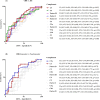Serum complement proteins rather than inflammatory factors is effective in predicting psychosis in individuals at clinical high risk
- PMID: 36631451
- PMCID: PMC9834035
- DOI: 10.1038/s41398-022-02305-1
Serum complement proteins rather than inflammatory factors is effective in predicting psychosis in individuals at clinical high risk
Abstract
Immunological/inflammatory factors are implicated in the development of psychosis. Complement is a key driver of inflammation; however, it remains unknown which factor is better at predicting the onset of psychosis. This study aimed to compare the alteration and predictive performance of inflammation and complement in individuals at clinical high risk (CHR). We enrolled 49 individuals at CHR and 26 healthy controls (HCs). Twenty-five patients at CHR had converted to psychosis (converter) by the 3-year follow-up. Inflammatory cytokines, including interleukin (IL)-1β, 6, 8, 10, tumor necrosis factor-alpha (TNF-alpha), macrophage colony-stimulating factor levels, and complement proteins (C1q, C2, C3, C3b, C4, C4b, C5, C5a, factor B, D, I, H) were measured by enzyme-linked immunosorbent assay at baseline. Except for TNF- alpha, none of the inflammatory cytokines reached a significant level in either the comparison of CHR individuals and HC or between CHR-converters and non-converters. The C5, C3, D, I, and H levels were significantly lower (C5, p = 0.006; C3, p = 0.009; D, p = 0.026; I, p = 0.016; H, p = 0.019) in the CHR group than in the HC group. Compared to non-converters, converters had significantly lower levels of C5 (p = 0.012) and C5a (p = 0.007). None of the inflammatory factors, but many complement factors, showed significant correlations with changes in general function and symptoms. None of the inflammatory markers, except for C5a and C5, were significant in the discrimination of conversion outcomes in CHR individuals. Our results suggest that altered complement levels in the CHR population are more associated with conversion to psychosis than inflammatory factors. Therefore, an activated complement system may precede the first-episode of psychosis and contribute to neurological pathogenesis at the CHR stage.
© 2023. The Author(s).
Conflict of interest statement
The authors declare no competing interests.
Figures




Similar articles
-
Changes in Inflammatory Markers in Clinical High Risk of Developing Psychosis.Neuropsychobiology. 2023;82(2):104-116. doi: 10.1159/000528770. Epub 2023 Feb 16. Neuropsychobiology. 2023. PMID: 36796338
-
Association of Attenuated Niacin Response With Inflammatory Imbalance and Prediction of Conversion to Psychosis From Clinical High-risk Stage.J Clin Psychiatry. 2023 Jul 17;84(5):22m14731. doi: 10.4088/JCP.22m14731. J Clin Psychiatry. 2023. PMID: 37471530
-
Changes in inflammatory balance correlates with conversion to psychosis among individuals at clinical high-risk: A prospective cohort study.Psychiatry Res. 2022 Dec;318:114938. doi: 10.1016/j.psychres.2022.114938. Epub 2022 Oct 31. Psychiatry Res. 2022. PMID: 36334327
-
P300 as an index of transition to psychosis and of remission: Data from a clinical high risk for psychosis study and review of literature.Schizophr Res. 2020 Dec;226:74-83. doi: 10.1016/j.schres.2019.02.014. Epub 2019 Feb 25. Schizophr Res. 2020. PMID: 30819593 Free PMC article. Review.
-
Inflammatory biomarkers in individuals at clinical high risk for psychosis (CHR-P): State or trait?Schizophr Res. 2018 Sep;199:31-38. doi: 10.1016/j.schres.2018.04.017. Epub 2018 Apr 25. Schizophr Res. 2018. PMID: 29703661 Review.
Cited by
-
Proteomic Biomarkers for the Prediction of Transition to Psychosis in Individuals at Clinical High Risk: A Multi-cohort Model Development Study.Schizophr Bull. 2024 Apr 30;50(3):579-588. doi: 10.1093/schbul/sbad184. Schizophr Bull. 2024. PMID: 38243809 Free PMC article.
-
Serum Levels of Tumor Necrosis Factor-α and Vascular Endothelial Growth Factor in the Subtypes of Clinical High Risk Individuals: A Prospective Cohort Study [Response to Letter].Neuropsychiatr Dis Treat. 2023 Sep 28;19:2055-2056. doi: 10.2147/NDT.S439097. eCollection 2023. Neuropsychiatr Dis Treat. 2023. PMID: 37790803 Free PMC article. No abstract available.
-
Advancements and Future Directions in Prevention Based on Evaluation for Individuals With Clinical High Risk of Psychosis: Insights From the SHARP Study.Schizophr Bull. 2025 Mar 14;51(2):343-351. doi: 10.1093/schbul/sbae066. Schizophr Bull. 2025. PMID: 38741342 Free PMC article. Review.
-
Body fluid biomarkers and psychosis risk in The Accelerating Medicines Partnership® Schizophrenia Program: design considerations.Schizophrenia (Heidelb). 2025 May 21;11(1):78. doi: 10.1038/s41537-025-00610-4. Schizophrenia (Heidelb). 2025. PMID: 40399418 Free PMC article.
-
The moderating role of lifetime social engagement on the relationship between C-reactive protein and negative symptoms among young adults at clinical high risk for psychosis.Brain Behav Immun. 2025 Oct;129:890-897. doi: 10.1016/j.bbi.2025.07.023. Epub 2025 Jul 27. Brain Behav Immun. 2025. PMID: 40730261
References
Publication types
MeSH terms
Substances
LinkOut - more resources
Full Text Sources
Medical
Miscellaneous

